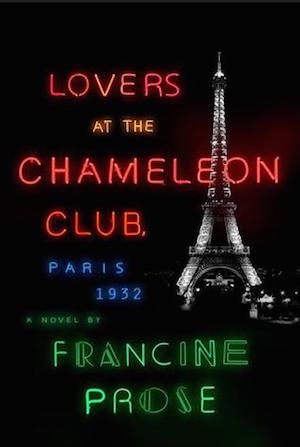William Faulkner wrote, “There is no such thing as was—only is. If was existed, there would be no grief or sorrow.” I’m always interested in things that might have been was, were they not so powerful as to be is. Lovers at the Chameleon Club, Paris 1932 considers those things carefully, fully, wisely, and with surprising heart.
Francine Prose’s novel was inspired by Brassaï’s photograph “Lesbian Couple at Le Monocle, 1932.” In the photograph a slight woman in an evening dress sits with a heavyset woman wearing a man’s jacket and tie. The woman in jacket and tie is Violette Morris, a former athlete and race car driver who eventually collaborated with the Nazis. Prose uses the details of Violette’s life to help create her central character: the cross-dressing lesbian Lou Villars. Lou endures a sad childhood, emerges a promising athlete, and begins to perform at the Chameleon Club. The club is named for the owner’s pet chameleon and is a hotspot for artists and cross-dressers of all sorts. Lou meets her first girlfriend at the club, starts to race cars, and eventually falls in with the Nazis. How Lou could go from Olympic hopeful to torturer extraordinaire would have been a fascinating story in and of itself. But Prose makes it even more interesting by not telling it as a single story. Instead she presents Lou’s life through the accounts and perspectives of a variety of friends, acquaintances, and interested parties.
Among the cast of characters that lend their voice to the collaborative sketch are Gabor Tsenyi, modeled after the Hungarian artist Brassaï who took the famous photopgraph of Violette; Lionel Maine, an American novelist in the mold of Henry Miller; Lou’s biographer Nathalie Dunois; and the owner of the Chameleon Club, Yvonne. They tell their stories in letters, essays, manuscripts, and memoirs.  Each account lends another brush stroke—sometimes a clashing brush stroke—to our portrait of Lou. But the one voice we never hear is Lou’s. By omitting her direct perspective, Prose allows us to fully explore her complications and contradictions. Life, particularly Lou’s, is never simple.
Each account lends another brush stroke—sometimes a clashing brush stroke—to our portrait of Lou. But the one voice we never hear is Lou’s. By omitting her direct perspective, Prose allows us to fully explore her complications and contradictions. Life, particularly Lou’s, is never simple.
How could a woman go from a patriot living a free and unconventional life in Paris, and hoping to represent her country in the Olympics, to a traitor willing to do unspeakable things to other Parisians on behalf of the Nazis? Had Prose included a direct account from Lou, we might have a clearer picture. But the story is more engaging because we are left to piece it together. Questions linger. What makes a person commit such atrocities? Does Lou betray her country because it betrayed her first, or does she feel that falling in line with the Nazis is the patriotic thing to do? What makes a person who they are? Is evil born or made? Reading this book is like putting together a jigsaw puzzle without knowing what the finished image looks like, or whether the pieces even belong to the same puzzle.
Ultimately, Lou Villars emerges through the gossip, innuendo, and speculation of individuals who are neither trustworthy nor particularly likeable. I found the process of stitching together her narrative from these disparate sources thoroughly engaging. Each account made me reconsider previous ones as well as what particular axe, if any, each narrator had to grind. The dubious portrait of Lou is reinforced by the fact that none of the narrators are particularly virtuous characters. It is a tremendous thing to create characters that we do not necessarily like but still find compelling and engaging.
I’m a longtime fan of Francine Prose’s writing and her power as a novelist. And I’m endlessly fascinated by the multi-layered, nuanced ways a person becomes who they are. Prose gives each of her characters not only their own voice, but also their own platform and agenda. And she tells Lou’s story without needing her to speak directly. To do all of this and still ask big questions about human nature is the work of a master writer, and it’s what makes Lovers at the Chameleon Club, Paris 1932 the last book I loved.





One response
OMG–I am so happy to see a review that captures by very thoughts about the book. It was engaging, creative, and so well written to drive the momentum of reading. The character development was “over the top”.
I read the book in November, and unfortunately not all of these new book club members agreed. I was aghast.
It’s been three months and I can’t find another book that I enjoyed as much. I’m almost considering Book Club therapy. HA.
Click here to subscribe today and leave your comment.